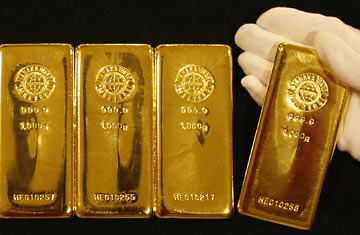
Pity Mr. T. It would cost the former chain-studded, 1980s TV star $1,000,000 to get dressed today. Earlier this week, gold hit $1,009 an ounce, an 18-month high and only the third time it has made it into the quadruple digits. Adjusted for inflation, the price of gold is three times what it cost when Mr. T's B.A. Baracus and the A-Team were on the air.
Typically, investors buy gold when they are nervous about the state of the economy. But the latest price run started in earnest in April, just as the fears of the financial crisis were easing. Demand for gold has been rising. And inflation, despite the mounting economic recovery, looks to remain in check. That has many thinking the rise in gold is just another sign that the global economy is on the mend.
"I think the move in gold reflects fundamental improvements," says Larry Adam, chief investment strategist at Deutsche Bank Private Wealth Management. "I don't see it as anything bad."
Still, there are some who believe the jump in bullion is an early warning sign that the U.S. government's efforts to quell the recession will backfire. The fear is that the trillions of dollars the government is spending to safeguard the financial sector and boost the economy could result in massive deficits and mounting inflation. "People who are buying gold are buying into the argument that the Federal Reserve will not be able to take back all the liquidity it has poured into the market and protect against inflation," says James DiGeorgia, editor of the newsletter Gold and Energy Advisor.
But unlike in the past, there is very little evidence to suggest that the recent jump in gold has anything to do with inflation. Gold prices started increasing around the time the government released results of the bank stress tests, which indicated that many of the nation's top banks would need little or no further financial assistance. Many point to the stress tests' positive results as the beginning of the end of the financial crisis.
And there are few signs that inflation will be rising anytime soon. The Consumer Price Index fell 0.2% in July and was down about 2% this past year. That's not inflation; that's the opposite. And while the economy seems to be recovering, it is still slow going. Unemployment continues to climb. Inflation, however, typically occurs when the economy is hot — the result of too many buyers for too few goods. Many think it will be months or years before the economy gains that much steam again. "Our prediction is that core inflation will not pick up until 2011," says Adam.
So what is driving the price of gold? Adam says demand. And that's a good thing. As the credit crisis and global recession eases, more and more consumers, and industrial users like electronics manufacturers, are buying gold again. According to World Gold Council, demand for gold, while down from a year ago, rose 19% in the second quarter vs. the first three months of the year. Indeed, gold prices might be rising in anticipation of the normal holiday buying season.
And gold is not alone. A number of commodities are up. The price of silver, which has many more industrial uses than gold, rose 40% this year vs. just 15% for gold. Copper prices have nearly doubled. Indeed, the broad rise in commodity prices that are occurring now is usually an indication of a resurgence in the economy, not trouble ahead.
"Usually when gold rises, you think something wicked this way comes," says Ed Yardeni, a top Wall Street strategist. "But things got so bad this time that I think gold, like everything else, is responding to the perception that things are getting better."
